1. Testicles and Epididymis The most common cause of orchitis in adult men is bacterial infection. In sexually active men, the most common cause of orchitis is chlamydia. Men have two testicles, one on each side in the scrotum. Each testicle produces sperm and testosterone. Sperm is produced and then stored in a special tubular structure called the epididymis. This is a tube that comes out of the tip of each testicle. These ducts further merge with the leading sperm ducts of the body. In addition, the testes come extremely close to each other and share some common membranes. Inflammation of the epididymis in the testicles has a similar clinical picture to orchitis. 2. What is orchitis? Orchitis is an inflammation of the testicular tissue. Infantile orchitis is the most common disease that is caused by a viral infection in childhood. One in 30 men who suffer from inflammation in the parotid glands – salivary glands in the oral cavity – also suffer from subsequently developed orchitis. The most common cause of orchitis in mature men is bacterial infection. In sexually active young men, orchitis is most often caused after chlamydia infection during sexual contact. Often, in men with orchitis, a disease of the genitourinary tract is also detected, which requires appropriate treatment. 3. What is the clinical picture? Orchitis is most often associated with the following symptoms – pain in the scrotum, which increases when moving, walking and rotating the hip joint. The scrotum is often swollen and red. The disease proceeds with increased body temperature and fever. The acute stage of the disease often lasts about a week, but the inflammation of the testicles may take several weeks to completely and permanently heal. NEWS_MORE_BOX 4. What treatment is used for orchitis? Urologists recommend treatment at rest. Pain with movement can be controlled with a bandage that compresses the testicles and limits their gravitational movement. Painkillers can also be administered, but in no case antibiotics, due to the risk of damage to the spermatozoa and parietal cells in the testicular tubules responsible for the production of the special hormone. 5. What is epididymitis? Inflammation of the epididymis is even more common than orchitis. It usually develops as a complication of an infection in the pyocococcal tract, most often due to bacterial invasion of the mucous membrane on the inner surface of the epididymis. In the past, gonorrhea was the most common cause of epididymitis. Nowadays, most cases are registered after the diagnosis of the presence of chlamydia. 6. What is the clinical picture? Symptoms can appear spontaneously and include – pain in the testicles at rest and during movement, increased body temperature and fever, edema in the epididymis, the skin of the scrotum is swollen and red. There is pain in the abdominal cavity, accompanied by urges to nausea and vomiting. Symptoms of infection in the genitourinary tract can also be encountered.These include burning pain when passing urine through the urinary tract. Cutting pain is also felt during the urge to urinate. The inflammation can also involve the entire testicles, which is very painful and is described as acute epididymorchitis. 7. How is epididymitis treated? Symptoms may last eight to ten days. During this time, the patient is placed on bed rest in complete rest from movement and antibiotic therapy. Discomfort symptoms gradually decrease – the temperature disappears, the pain decreases and the swelling of the testicles is controlled. It may take more than six weeks for the swelling and trauma to the scrotum to completely subside. If the pain is severe enough, doctors recommend switching to stronger painkillers and narcotic analgesics.


Leave a Reply